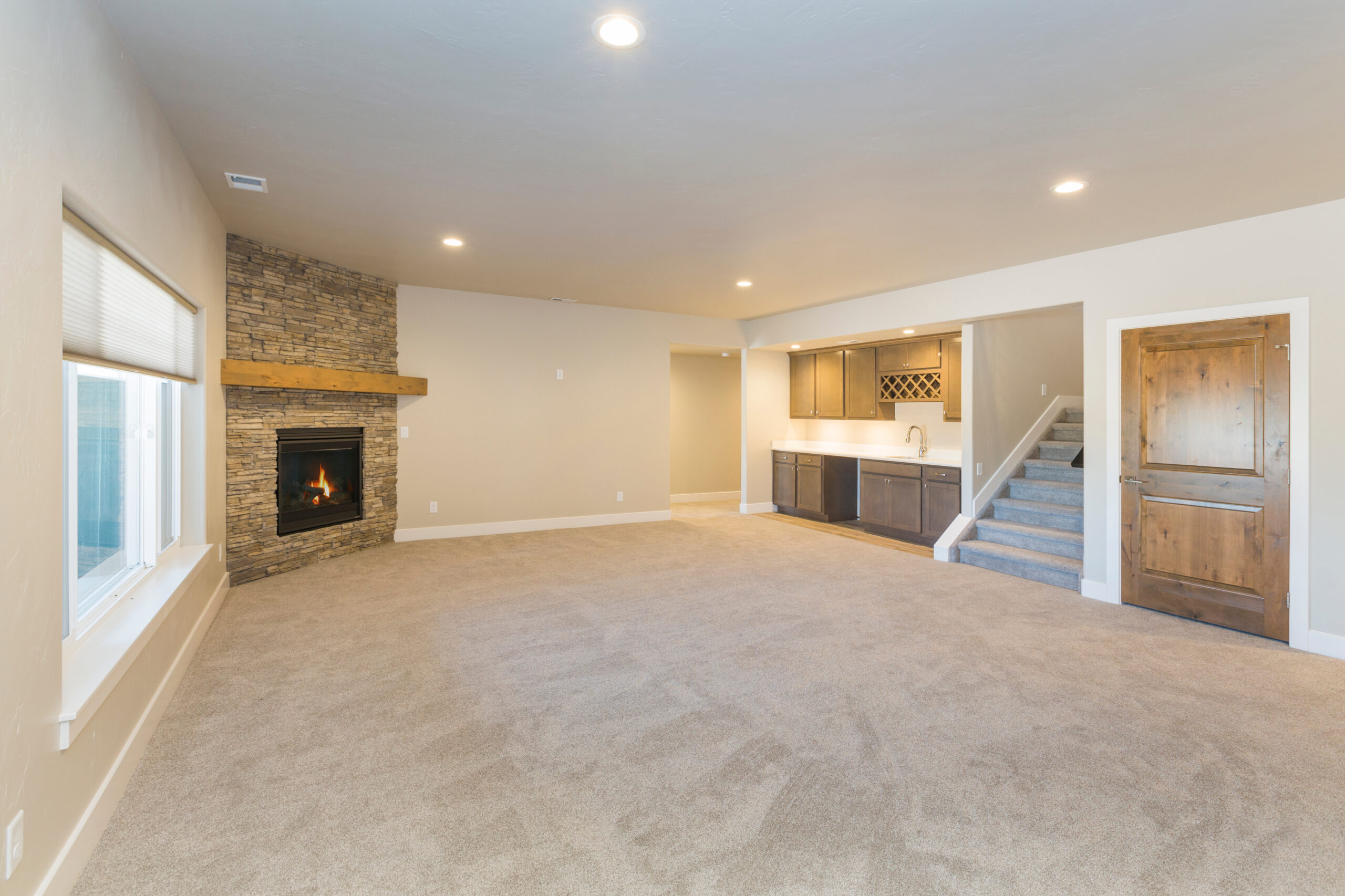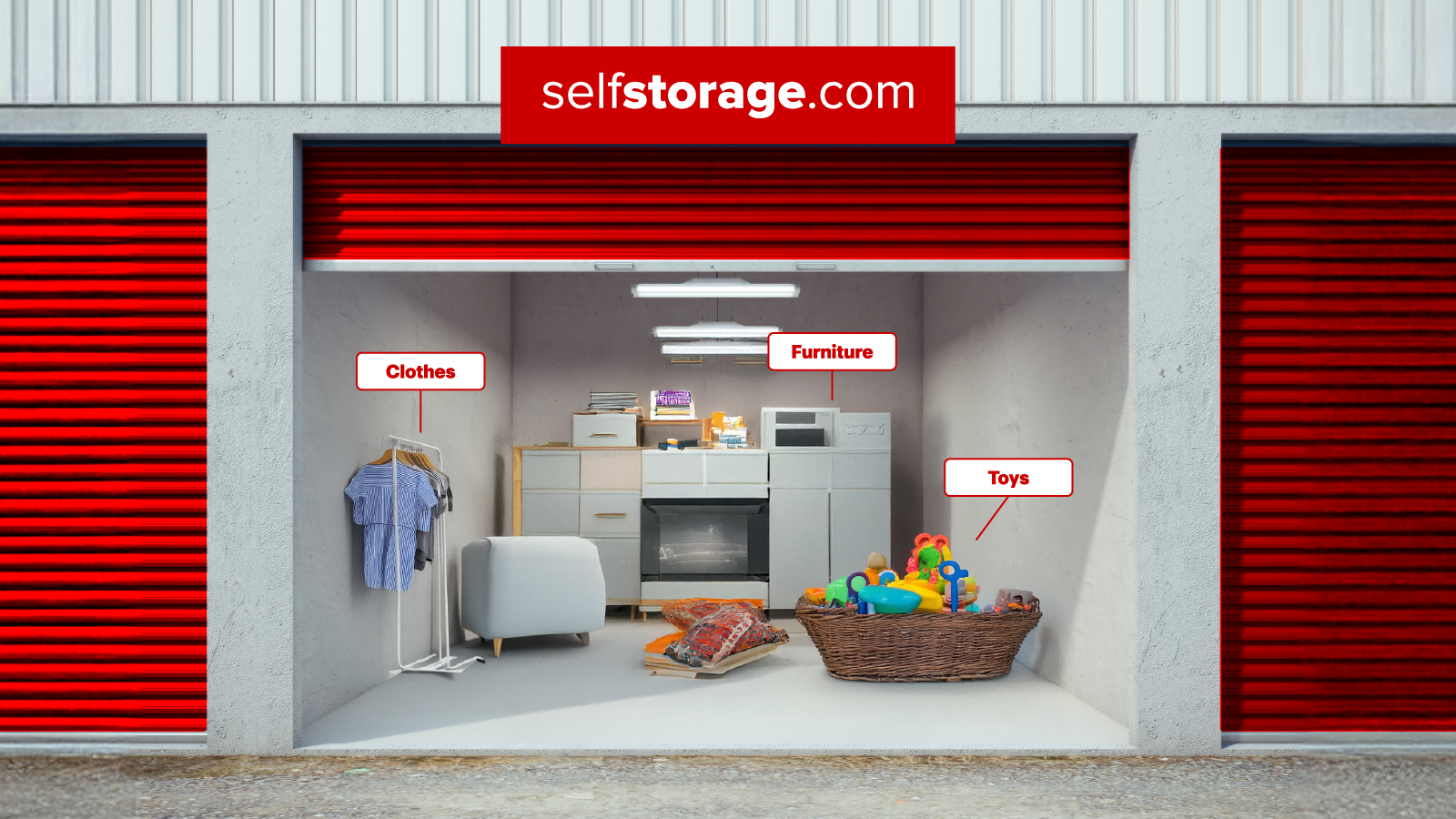Method 1: The 4-Box Speed Sorting System
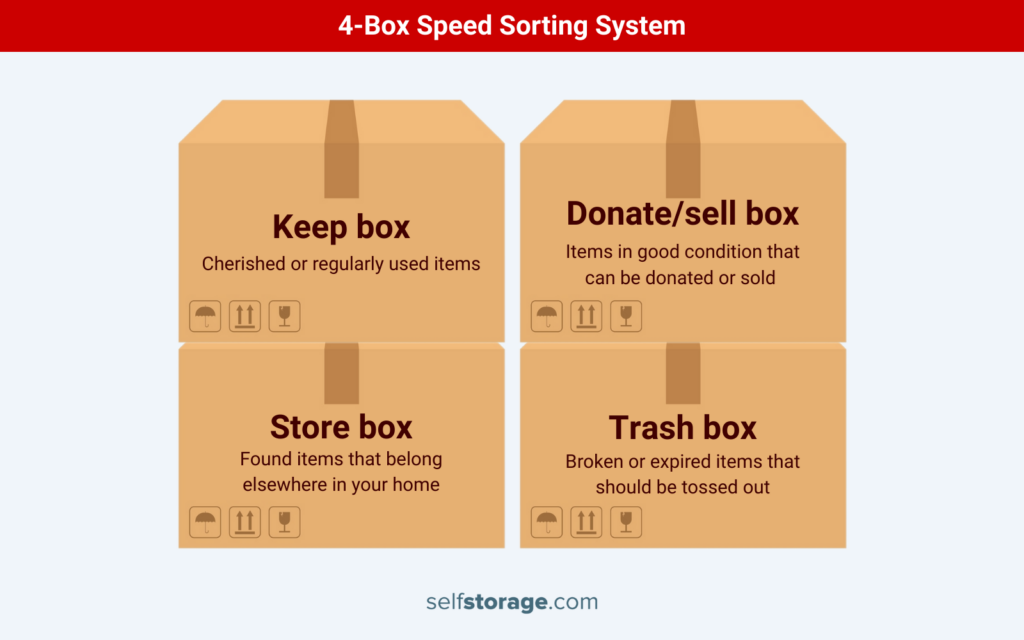
The 4-box speed sorting system is a go-to decluttering hack for a speedy basement organization. This method helps you make quick decisions and avoid becoming stymied by overthinking or indecision. Set a timer for one hour and move quickly through your basement, placing each item into its appropriate bin.
You’ll need 4 large, clear storage bins. Double up if you have a large volume of clutter to sort–just make sure each box or set is labeled and categorized as follows:
- Keep box: For cherished or regularly used items
- Donate/sell box: For items in good condition that can be donated or sold
- Store box: For found items that belong elsewhere in your home
- Trash box: For broken or expired items that should be tossed out
Quick tips to streamline this process even further:
- Group similar items together and work through them one section at a time.
- Take before and after photos of your space to track your progress and stay motivated.
- Ask decision-making questions to avoid becoming stuck:
- “Have I used this item within the last year?”
- “Do I realistically expect to use it within the next year?”
- “Would I buy the item again?”
Consider renting a small self-storage unit to temporarily house excess items while you sort out a longer-term storage solution.
Method 2: Zone Basics Without the Work
The Zone Basics method is a simple way to make quick work of large basement organization tasks. Place colored floor tape you can find at any hardware store along the floor to divide your basement into clearly visible sections, or zones, you can work through one at a time.
As you plan your zones, try grouping your items by type: seasonal decor, tools, toys, clothing, etc. You’ll also want to leave room to move freely between zones, so as you tape off each section, create wide walkways between them and keep these clear of boxes, furniture and other clutter.
Quick tips for extra storage:
As always, a self storage unit is the go-to for bulky or seldom-used but needed items, or anything harder to easily categorize and put away at home. This will free up space to make your zones more usable and accessible.
Method 3: Ready-Made Shelving Solutions
Ready-made shelving is an effective DIY solution for basement organizations. Look for no-assembly options that click or slot together for a quick installation that can be up and ready in minutes. Budget-friendly shelving units will typically be made of heavy-duty plastic or metal wire, and there are numerous options and sizes to choose from that won’t blow your budget.
Triangular corner shelves fit neatly into 90-degree wall junctions. Taller, narrower units can be placed against the walls and wider, shorter units beneath windows.These time-saving plug-and-play organization systems will help you speed through your weekend basement organization project.
Items that won’t fit standard shelves may be candidates for a self storage unit instead.
Method 4: Instant Vertical Space Maximizers
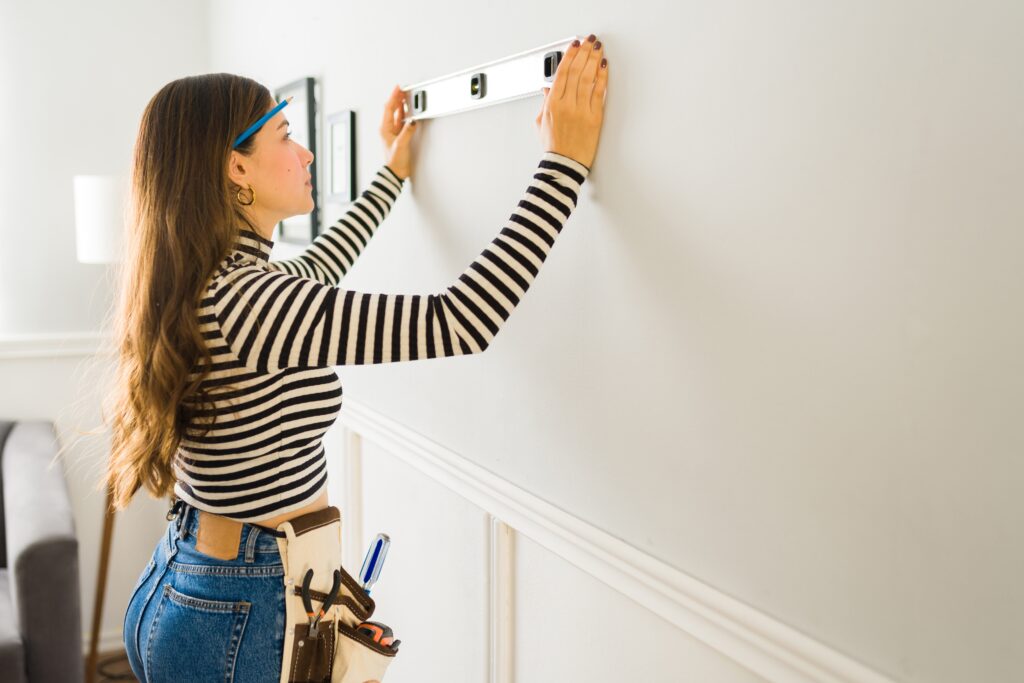
The most commonly overlooked basement organization storage solution is vertical storage.
Vertical storage offers crafty decluttering hacks that clear your basement floor to help create more usable space.
- Tension rods can be used to create makeshift partitions for hanging garments.
- Over-door hooks are useful for hanging light handheld cleaning tools, like brooms, mops or dusters.
- Command adhesive wall hooks are perfect for organizing cords, lightweight tools, or hanging bags of sporting equipment.
- No-drill wall hanging systems, which are often adhesive or tension-based, can be used to organize smaller, lightweight items.
- Pegboards are popular solutions for organizing craft supplies for easy access.
Consider renting a self storage unit for any items that don’t find a ready home in any of these categories.
Method 5: The Clear Container Quick-Switch
Clear bins are your basement makeover’s best friends. Choose stackable bins of the same size throughout your basement so you can maximize your floor space and easily see what’s inside each bin. Use fast labeling solutions like painter’s tape and Sharpies to label and categorize each bin to create a long-lasting and effective basement organization system.
The same kinds of containers and labeling systems should be used if you choose a self storage solution to extend your storage options. These bins are easy to move, simple to manage and easy to sort and transfer when needed, with minimal disruption to your overall system of organization.
Method 6: One-Hour Overhead Solution
Odds are you may not have considered one of the most unique ideas for storage in your basement: your ceiling.
The “One Hour Overhead Solution” prioritizes simple storage solutions for storing lightweight items from the ceiling. Quick-install ceiling hooks allow storage of bikes, sports equipment, textiles or bags of seasonal decor. You can also make use of existing ceiling features like exposed joists by adding simple planks or netting between them.
Ceiling storage requires a safety-first mindset. Make sure any installations, nets or planks are secure and strong enough to support the items you intend to store. Items too heavy for overhead storage that don’t fit elsewhere in your basement organization system are often better off in a self storage unit, which can house them safely.
Method 7: The Weekend Purge Formula
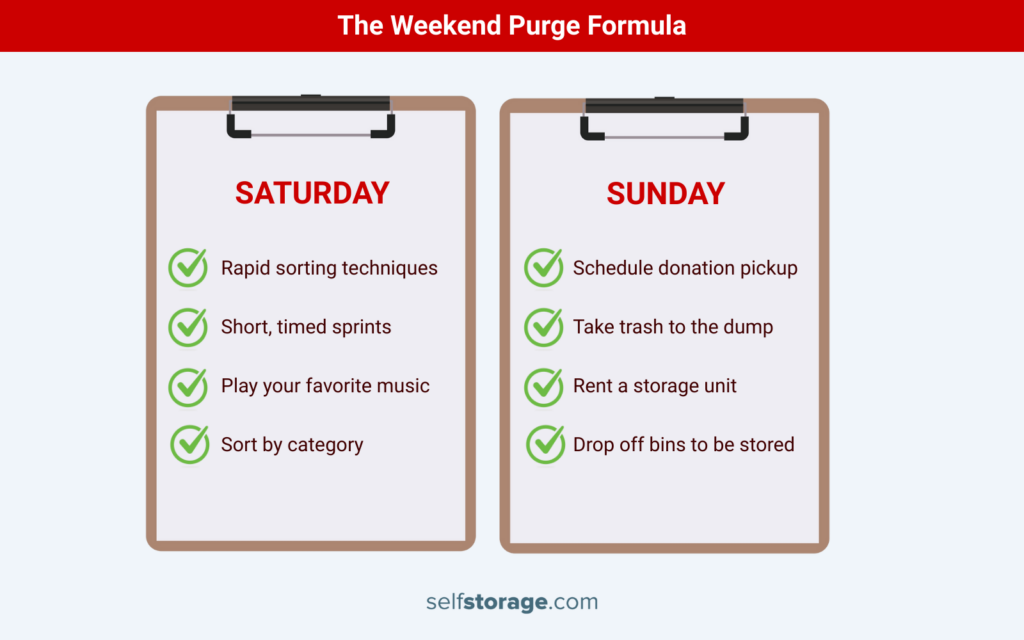
A total basement organization in a single weekend is absolutely doable with the right approach, and this is where the step-by-step 2-day Weekend Purge Formula comes in handy.
Saturday:
- Start with rapid sorting techniques like the “4-Box Speed Sorting System” to make quick decisions about what to keep, discard and store.
- Employ short, timed sprints of 15-30 minutes to stave off physical and mental fatigue.
- Play your favorite music to stay energized and focused.
- Sort by category: seasonal, sports, kids’ stuff, miscellaneous, etc.
Sunday:
- Schedule a donation pickup or take designated trash to the dump.
- Rent a storage unit and drop off bins to be stored.
A temporary self storage unit can be a great option to get larger items out of the way to create some room for sorting and organizing your basement.
Method 8: Instant Family Storage Stations
An active family can create enough clutter to overwhelm even the most spacious basement. Adding designated family storage stations to your basement organization will help conquer the chaos.
Pre-labeled bins, crates or cubbies labeled with names or photos are popular solutions to get family clutter under control. These are quick, no-build, personal DIY storage zones you can place along a wall to create a place for everything. These systems also make it easy to establish simple rules for each family member to routinely put away their things.
A family “seasonal switch” station uses one storage bin per person for off-season clothes or gear. This system creates a clutter-free basement by keeping only one bin per person per season at home, while storing each person’s off-season bin in a dedicated self storage unit.
Method 9: The Stair-Step Quick Fix

Unutilized space under your stairs is a storage goldmine. This is a no-construction space for tucking storage products designed for stair spaces, such as rolling drawers, narrow shelving or soft bins. Tension rods install quickly so you can hang a curtain to keep your under-stair storage hidden from view.
Under-stair storage is best suited to small, durable household items. Items that are too valuable for under-stair storage, like sensitive, expensive electronics or valuables, may be more appropriately stored in a climate-controlled storage unit.
Method 10: The 15-Minute Moisture Solution
If moisture is an issue in your basement, the 15-Minute Moisture Solution offers fast moisture prevention techniques you can implement instantly as part of your basement organization. All this can be done in 15 minutes, and it will help ensure your items are stored safely.
- Portable dehumidifiers or moisture absorption packs can be placed near moisture-prone areas.
- Plastic risers or bricks elevate items off the floor to protect them from water damage.
- Choose waterproof containers and bins instead of cardboard to pack items
- Moisture indicator strips alert you to moisture near walls and corners.
More serious moisture issues are not worth risking your valuable items. A climate-controlled self storage unit is ideal to ensure precious items like photos and valuables remain well preserved and protected.
Method 11: Rapid Seasonal Rotation
A simple, bin-based, rapid season rotation system creates DIY storage that can help you maximize space.
- Label large, clear bins by season–winter, spring, summer, fall, holidays and events, and group like items accordingly.
- Pack and store labeled bins for easy access on shelves or in a corner zone.
- Set a recurring 3-month calendar reminder for a quick 30-minute inventory to swap and refresh items as needed.
If you have a self storage unit, you can apply a recurring 2-hour seasonal rotation system to allow enough time for you to manage and swap your stored items away from home.
Method 12: Instant Workshop Organization

If you are tackling an untidy basement workshop, a few basement organization options can help straighten up your workspace:
- Ready-made roll-away carts specifically designed for tool organization in garages or basements allow for fast organization of a variety of work tools.
- Pegboards can be quickly mounted or leaned against a wall to hold lighter tools and accessories.
- A simple, affordable DIY workbench could be a heavy-duty folding table, or a a sturdy piece of plywood placed over two sawhorses.
- Metal bins or storage lockers can help categorize and store hand tools, power tools and other equipment and accessories.
Seasonal or infrequently used large tools that take up valuable space can be stored in a self storage unit to free up extra room.
Method 13: Self-Storage Express Option
Use the Self-Storage Express Option to help choose a storage unit and the items to go into it, all within 30 minutes.
The formula is simple: Anything large, seasonal, sentimental but unnecessary or not used regularly goes into storage. Use clear, labeled bins neatly stacked onto shelving in your unit to quickly organize these items, with items you use most placed toward the front.
Choose a unit close to home with easy, drive-up loading for quick access to your things. If you are storing delicate items, choose a climate-controlled unit, and be sure you have accurately inventoried the number and size of items you are storing to ensure your unit fits your items, with enough room to walk in and manage your belongings.
Method 14: The 1-Hour Off-Floor System
Moisture and other damage to items in your basement can be kept at bay by storing as many items as possible off the floor, which allows for better ventilation and to keep things dry. Use waterproof brick or cement risers, or ready-made plastic pallets as base layers, and stack items by group on top in clear, labeled, waterproof bins.
A basement with more serious moisture issues, leaks, or flooding as is common in some older homes, may not be safe for storing your items long-term. A basement organization is a good time to move vulnerable items to a self storage unit for safekeeping instead.
Method 15: The 30-Minute Maintenance Plan
Once your basement makeover is complete and your space is clean, keep it that way. An easy, 30-minute weekly maintenance plan, cleaning rotation and a simple set of rules for everyone in the home or family will keep your basement organized.
- Create a recurring calendar reminder for 30 minutes on a weekend day to tidy high-traffic areas, refresh bins and toss or rehome anything that doesn’t belong.
- A catch-all bin can be placed in a corner for new or uncategorized items to be sorted and put away.
- A to-do list on a whiteboard can list assigned duties to keep family members accountable and on task.
The same maintenance plan works for a self storage unit. A regular rotation for organizing, swapping and editing your space will keep your self-storage unit tidy for the long haul.
Weekend Implementation Timeline
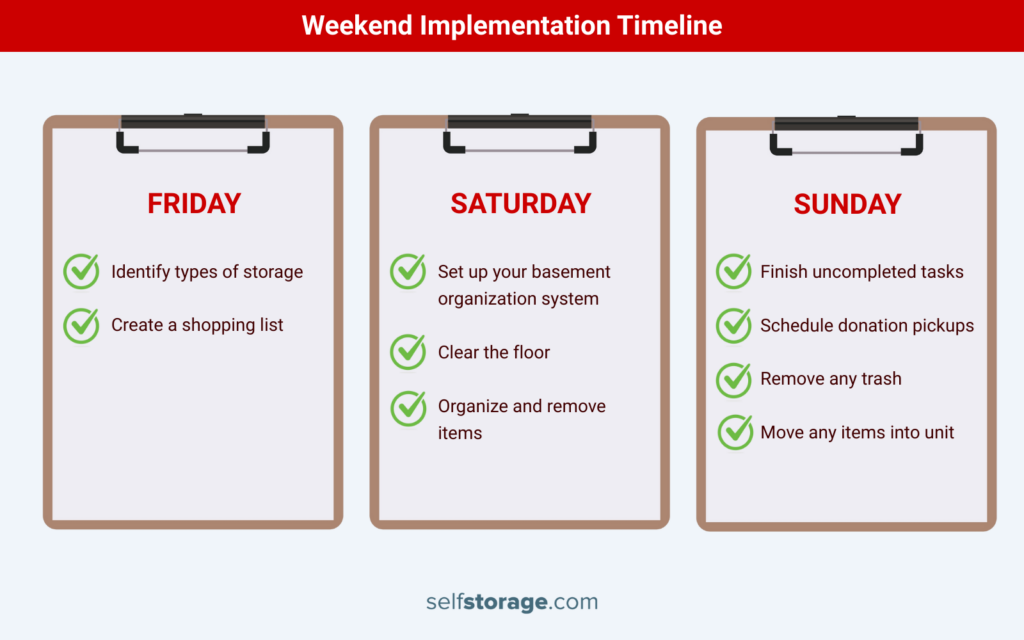
The Weekend Implementation Timeline creates a practical, hour-by-hour schedule to help guide you as you work through your basement organization.
Fast Friday night prep:
- Identify the types of storage you will need for your space.
- Create a shopping list of the storage items you need to buy: hooks, nets, hangers, bins, tension rods, shelves, etc.
Saturday morning to afternoon:
- Set up your basement organization system(s): 4-box system, floor tape system, shelving units, ceiling storage hooks, nets or planks, etc.
- Clear the floor, using your decluttering system of choice to sort, organize and remove items from your basement space.
Sunday morning to afternoon:
- Finish any uncompleted organizational tasks from Saturday
- Schedule donation pickups and dropoffs and remove any trash
- Move any items you’ve designated for storage into your new unit.
Remember to take frequent rest breaks throughout each day, keep snacks and drinks on hand to stay hydrated and fueled, and maintain realistic expectations for yourself based on the size and complexity of the task at hand.
SelfStorage.com Can Make Your DIY Basement Organization Dreams Come True
These 15 methods for a total weekend basement organization will ensure you’re enjoying your newly organized basement by Monday morning. Success is easy: Make sure you have carefully evaluated your basement space, your needs and the solutions that will work best to meet them.
And utilize a self storage unit to hold any unwieldy items, or temporarily house things to create immediate space while you organize at home.
We invite you to share your quick results and how these ideas for storage in your basement have transformed your home. If you’re ready to get started, explore fast, convenient storage options at SelfStorage.com today. Freedom from your basement clutter is just a few clicks away.
